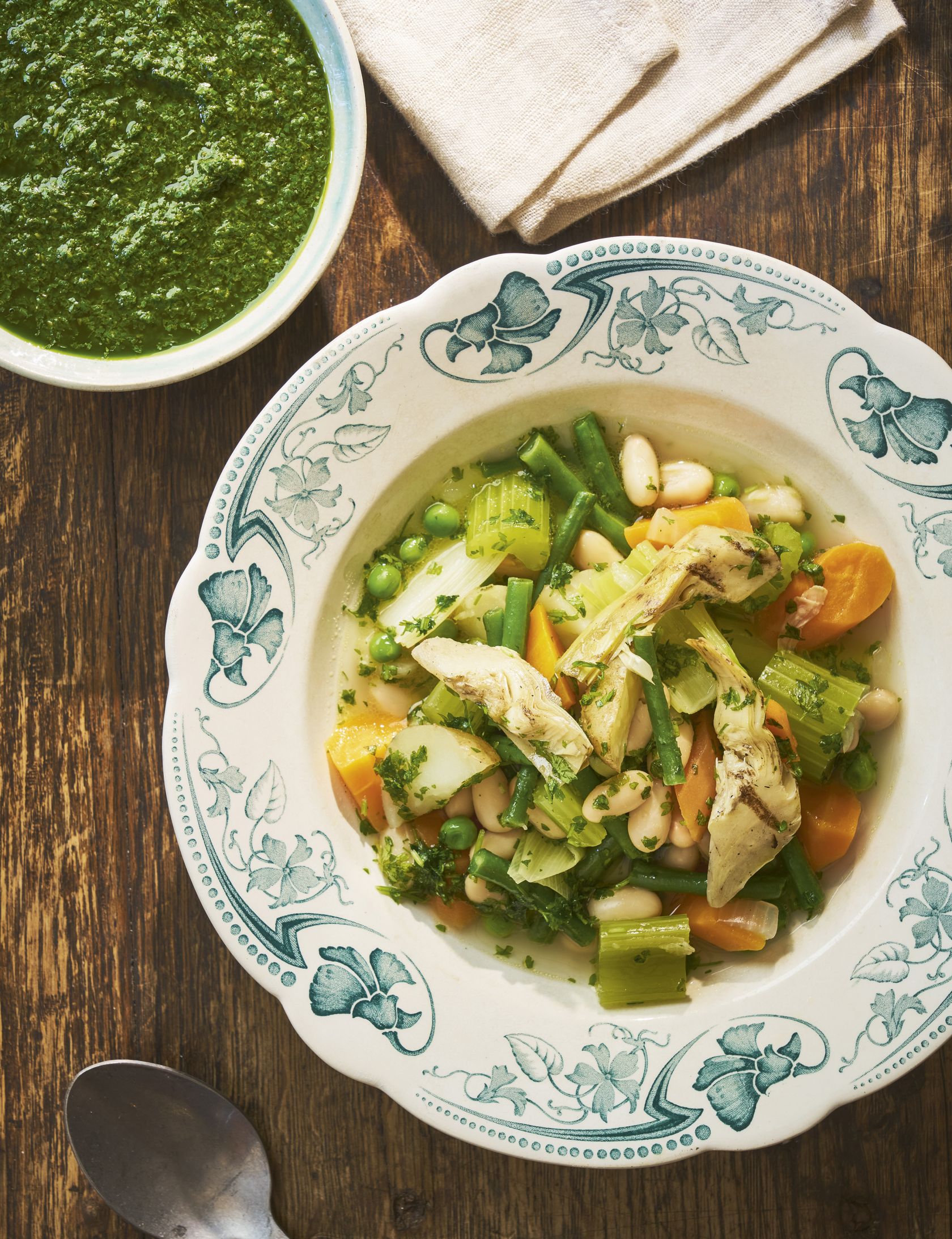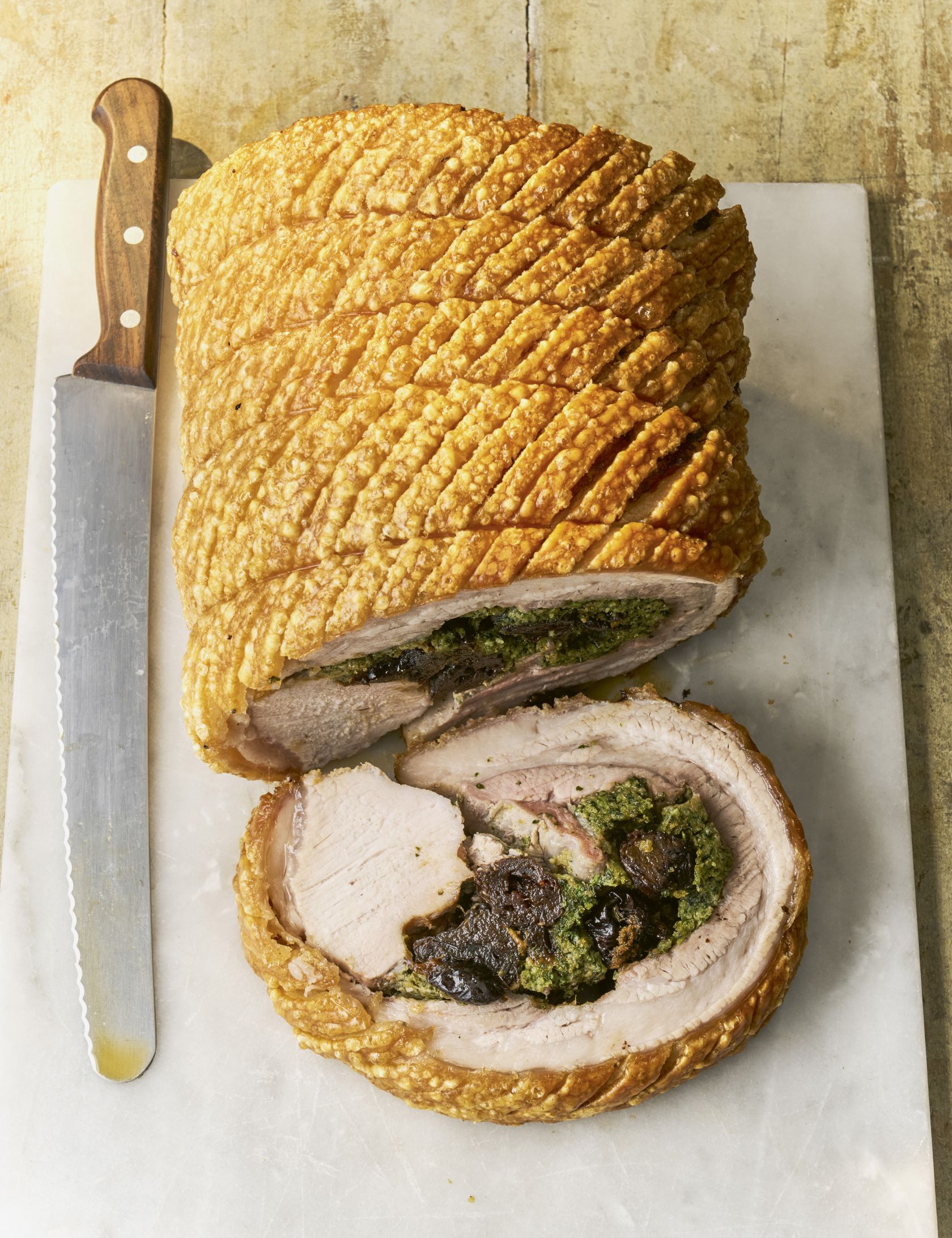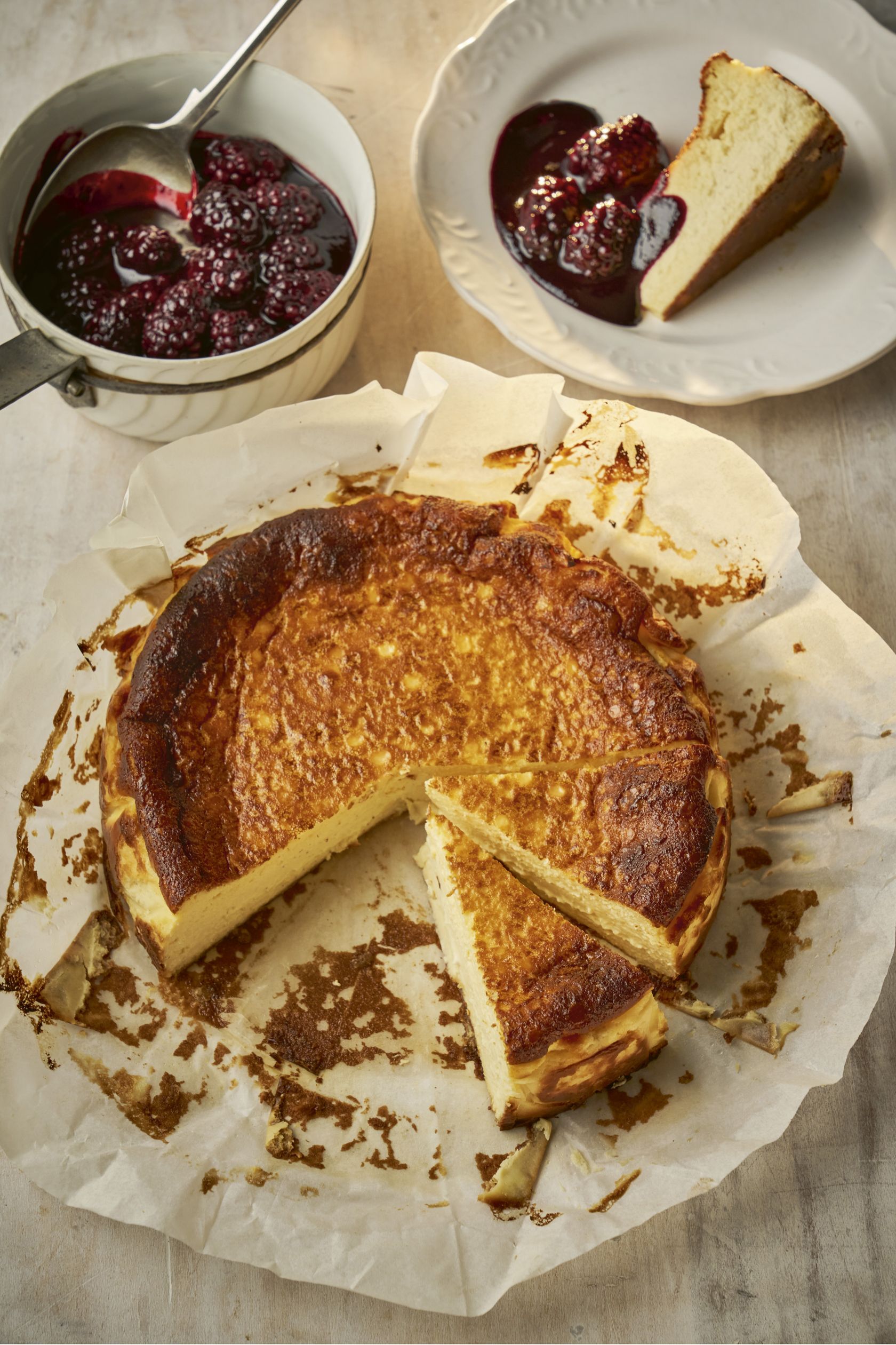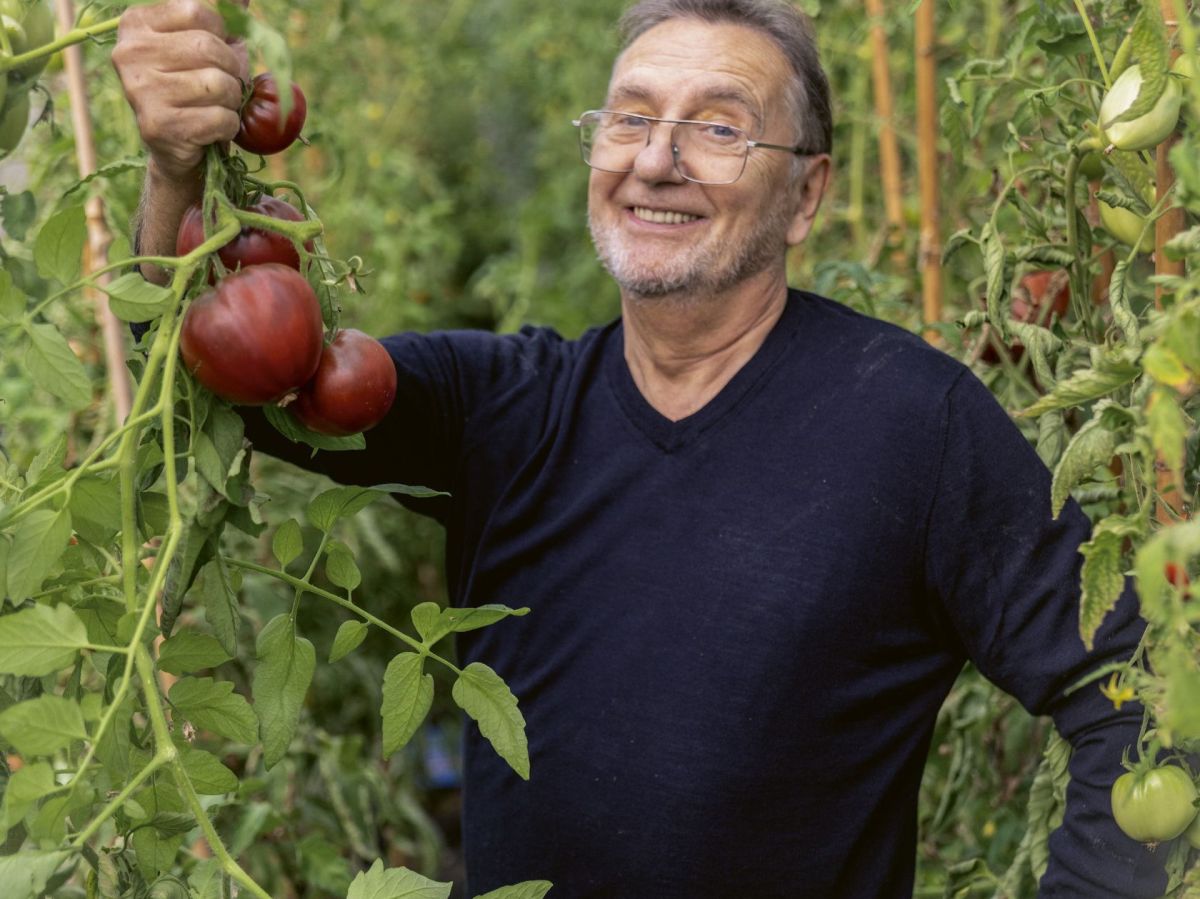The French chef opened world-famous Le Manoir aux Quat’Saisons 41 years ago with expansive grounds – and the concept of ‘garden to plate’ was born.
Now, with 250 different organic varieties of fruit and veg growing and 27 acres in total, the gardens aren’t just crucial for the two-Michelin star Oxfordshire restaurant and hotel, but for him personally too.
His new book celebrates the variety of fruit, herbs and veg we’re able to grow in the UK, and the beauty of it in all its simplicity; from his kitchen garden omelette and courgette galette, to the comté cheese and leek souffle and roasted pork stuffed with prune and herb breadcrumbs, before rhubarb and custard tartlets.
Potager Casserole

Prep: 10 mins
Cook: 20 mins
Ingredients:
(Serves 4)
1 small onion
1 large garlic clove
160g new potatoes
1 small leek
1 large carrot
1 stick of celery
60g fine green beans
120g frozen broad beans or peas
1tbsp olive oil
1 bay leaf
Seasalt and ground white pepper
700ml boiling water
4 jarred artichoke hearts
1 tin (400g) cannellini beans or white haricot beans
For the pistou:
A bunch of basil
2 garlic cloves
100ml extra-virgin olive oil
2 pinches of sea salt flakes
A pinch of ground black pepper
To serve:
10g chervil
Method:
1. Make the pistou: Coarsely chop the basil. Chop the garlic to a purée. Bring a medium-sized saucepan of water to the boil, and meanwhile half-fill a medium-sized bowl with iced water. Plunge the basil into the pan of boiling water and blanch for 30 seconds. Remove and refresh in the cold water, and then drain. With a stick blender or in a food processor, blend the blanched basil with the extra-virgin olive oil, chopped garlic, salt and pepper to a purée. (Pistou can be stored in a sealed container in the fridge for four days. It also freezes well).
2. To prepare, dice the onion. Crush the garlic to a purée. Quarter the potatoes. Remove and discard the two outer layers of the leek, halve it lengthways, coarsely chop and wash. Halve the carrot lengthways and coarsely chop it. Coarsely chop the celery. Coarsely chop the green beans (about two centimetres). Place the frozen broad beans (or peas) in a small bowl and cover with water straight from a boiled kettle.
3. In a large saucepan or casserole dish over a medium heat, heat the olive oil and add the onion, garlic and bay leaf, along with a couple of pinches of salt and pepper. Cook for about three minutes.
4. Add the potatoes, leek, carrot, celery and green beans. Stir and continue to sweat the vegetables for a further three minutes.
5. Pour in the boiling water and simmer for 12-14 minutes. Test the vegetables are cooked by simply tasting. Adjust the seasoning, if necessary.
6. Remove the pan from the heat and add the artichoke hearts and cannellini beans (or haricot beans). Drain the broad beans (or peas) and add these to the pan. Chop the chervil and add it. If using pistou, now is the time to add it – to your taste – and stir it into the casserole. If necessary, reheat the casserole, divide it into four shallow bowls and serve.
Roasted pork stuffed with prunes and herb breadcrumbs

Prep: 30 mins
Cook: 2 hours
Rest: 45-60 mins
Ingredients:
(Serves: 8-10)
For the herb breadcrumbs:
2 thyme sprigs
1 rosemary sprig
2 bunches of flat-leaf parsley
2 garlic cloves
100g dried or fresh breadcrumbs
60ml extra-virgin olive oil
2 pinches of sea salt flakes and a pinch of ground black pepper
For the pork:
4.5kg pork belly with the loin attached, prepared for porchetta (ask the butcher to do this for you)
5 pinches of sea salt flakes
2 pinches of ground black pepper
500g Agen prunes, pitted
3tbsp vegetable oil
Method:
1. First, make the herb breadcrumbs (you need 500 grams). Pick the leaves from the thyme and rosemary sprigs and finely chop them. Coarsely chop the parsley. Peel and slice the garlic cloves. In a food processor (or with a handheld blender), blend the breadcrumbs, garlic, thyme and rosemary until fine. Add the parsley and blend on full power until the crumbs are bright green and evenly blended. Stir in the extra-virgin olive oil. Season with salt and pepper.
2. To prepare the pork, unroll the pork belly skin-side up, ensuring the loin is still attached. If scoring the skin at home, score it with a sharp knife (or razor blade) in a criss-cross (leave a two centimetre gap between each scored line). Score only the skin and don’t cut into the meat.
3. Turn over the pork belly and season the loin with two pinches each of salt and pepper. Scatter over the herb breadcrumbs and lay three rows of prunes across the belly.
4. Cut eight pieces of kitchen string long enough to go around the joint. You might need someone to help you at this point … Roll up the pork joint, starting at the loin so that the lines of prunes and breadcrumbs stay in place; now, while one person holds the rolled joint securely, the other person should tie the string tightly at even points along the joint.
5. Place the prepared pork in a large roasting tin. Rub the oil all over the skin and scatter over the remaining three pinches of salt. Preheat the oven to 210°C/190°C fan/gas 6½.
6. Place the roasting tin on the bottom shelf of the oven and roast for 30 minutes, and then reduce the temperature to 180°C/160°C fan/gas 4 and roast for a further 1 hour 30 minutes. If using a cooking thermometer, the centre of the pork should be 65-67°C (149-152°F).
7. Remove the pork from the oven and allow it to rest loosely covered with foil for 45-60 minutes before serving. This resting time is essential for the pork to carry on cooking to a temperature above 70°C (158°F), and resting enables the meat to become succulent, tender and juicy.
Basque-style cheesecake

Prep: 15 mins
Cook: 25-30 mins
Ingredients:
(Serves: 8)
For the cheesecake:
1tsp unsalted butter, softened, for greasing the tin
1 lemon, for zesting
550g cream cheese
175g caster sugar
4 eggs (preferably organic or free-range)
250ml double cream
2tsp Vanilla Bean Purée (see page 285 of the book) or 4tsp shop-bought vanilla bean paste
20g cornflour
Method:
1. Preheat the oven to 220°C/200°C fan/gas 7 (here, it is best – but not essential – to use the fan-assisted oven).
2. Use your fingertips to rub the soft butter around the inside of a springform cake ring (or mousse ring) with a diameter of 20 centimetres so that the greaseproof paper will stick to it. Now line the inside of the ring with a large sheet of greaseproof paper, making sure it fits neatly into all the edges and the base of the ring. Place the lined ring on a baking tray and keep aside.
3. Zest the lemon and keep the zest to one side. In a large bowl, whisk together the cream cheese and caster sugar until smooth. Add the eggs and whisk again to an even consistency. Next, pour in the double cream, add the vanilla and lemon zest and sift in the cornflour. Whisk again, ensuring there are no lumps in the mixture. Pour this mixture into the prepared tin.
4. Bake for 25 to 30 minutes on the middle shelf of the oven until the top has that distinctive dark sheen of traditional Basque cheesecake. Halfway through cooking – and depending on your oven – you might need to turn the cheesecake 180 degrees so that it is evenly browned. (Chris’s photograph is a good guide to what the cheesecake top should look like.) The sides of the cheesecake should be slightly firm and the centre should have a gentle wobble.
5. Remove the cheesecake from the oven and set it to one side to cool (it will continue to cook as it cools). Place the cooled cheesecake in the fridge for at least half a day or overnight to firm up.
6. To serve, remove the springform cake or mousse ring and gently peel back the baking paper. Serve slices of the cheesecake with lightly stewed blackberries, if you wish, or a fruit preserve of your choice.

Simply Raymond Kitchen Garden by Raymond Blanc is published in hardback by Headline Home














